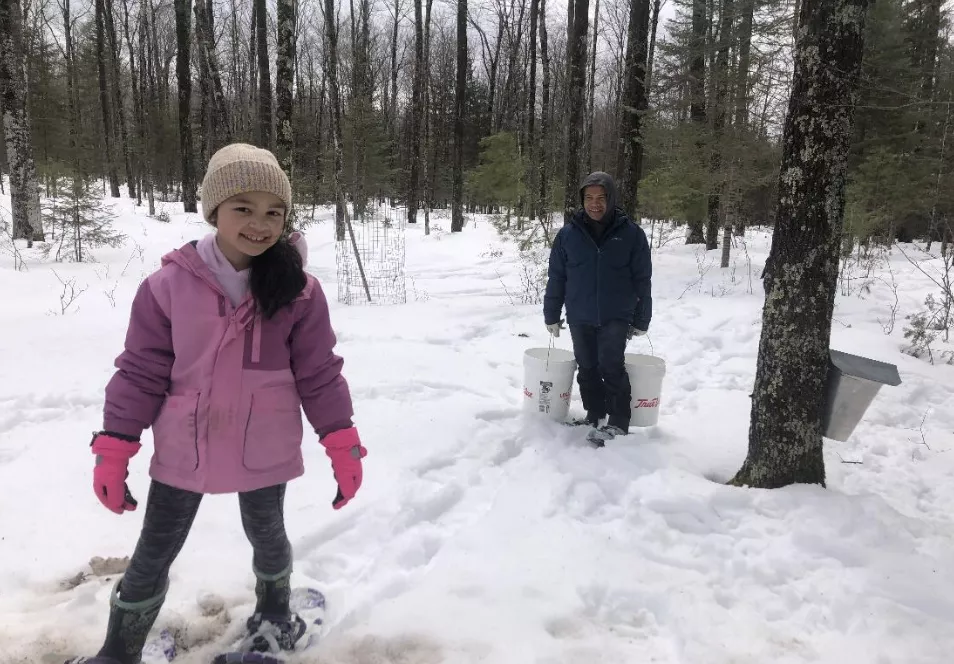Steigerwaldt 2023 Maple Syrup Report – First Edition
“Effect of Weather on Maple Syrup Production”
Almost everyone, including me, associates maple syrup production with those beautiful early spring days. Those are the ones where night temperatures fall to approximately 10 degrees and rise to 40 – 50 degrees during bright sunny days.
While we settle into spring, we wanted to reflect back on maple syrup season. Our memories always come back to the best times first. It’s no different with making maple syrup.
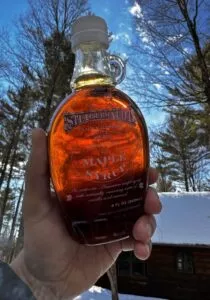
The 2023 maple syrup season in northern Wisconsin began with pretty normal weather. We started with two feet of snow on the ground and typical February and early March temperatures. By the end of February, we had 200 trees tapped and were waiting for the first sap run. For more information about how our operations work click here to see the Steigerwaldt 2019 Maple Syrup Report – First Edition.
By March 8 our crew had collected 240 gallons of sap, but then things changed. Rather cold weather persisted until late March when we had another warm up and we could collect another 240 gallons.
In past years we were close to the end of the Steigerwaldt syrup season, but we fell way behind when almost two feet of wet, heavy snow fell, and high winds arrived on April 1. Cold temperatures resulted in another weekend with a sap run and truly miserable conditions to gather sap, when it does run. Finally, on April 5, we had enough of a warm-up that sap ran and we could finish 10 gallons of syrup and bottle it.

Ted, late February, tree tapping
Ideal conditions are up and down temperatures where sap moved up during the warmth of the day. What 2023 has brought is one or two such days and seven to ten days of way too cold freezing temperatures.
The syrup season hit pretty late and as time went by, the prospects for sap collection dimmed. The week after Easter brought highs of 58 to 70 degrees, ending sap production for the year. Sap sugar content drops as the season wears on and also there are more nitrates and bacteria present. This is normal, and not a health hazard, but creates darker syrup which often has a stronger taste.
I suspect that maple syrup producers in the lower Midwest have faired much better than those in northern Michigan and Wisconsin. These areas just had too much snow and cold temperatures during what should be prime sap running time.
The late and heavy snowfall also made it wet, sloppy, muddy, and somewhat tough conditions to work in. See the photos below.
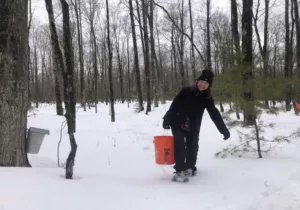
Julie collecting sap on snowshoes

Snow piles around the cabin
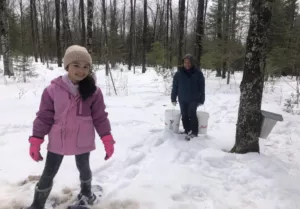
James and Greta collecting sap in 16 inches of snow
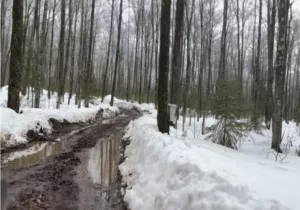
Muddy roads
We also operate the wood stove, finishing, and bottling in cold and high wind when present, which this year seems always.
In spite of the challenges, we feel fortunate. As a forester, I usually think of maple forests as a low-risk asset because hardwood forests rarely burn in the Lake States. Wind, however, is a different story. For example, September 23, 2022, saw hurricane winds hit Nova Scotia, Canada, with 110 mph winds that caused $1.5 billion in damage. Many maple forests were totally destroyed, and the maple syrup industry there will be impacted for decades.
Maple syrup‘s popularity continues to grow both as a commercial industry and as a hobby. Please see the chart below:
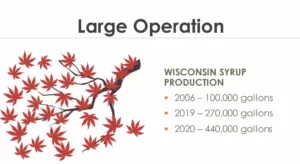
By early March most local maple supplier’s equipment was sold out of evaporators and various bottles and jugs. This is just another sign of how popular maple syrup is.
Some other interesting statistics:
- The number of taps increased from 20,000 to 920,000
- Syrup yield was 4.78 million gallons

I’ve always said that the real payoff for small producers like us is the fun of the entire process. Where else can you take something like gin clear sap and make it into something special in less than a day! For us, it’s family and friends working together. The process is fun for adults and children, plus everyone develops an appreciation for the outdoors and outdoor work.
One interesting fact about 2023 is that the slow run, freezing, and thawing left us with lots of ice in our collection pails. By picking out the ice we can concentrate the sap and bring the normal sap sugar content from approximately 2 percent to as high as 6½ percent. That means that we change the evaporation from 40 gallons/per gallon of syrup to as little as 15 gallons. This is a big-time and firewood saver.
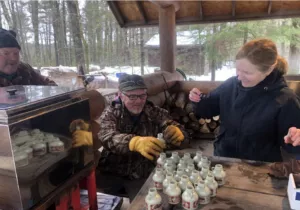
Todd Frederickson, Tom Graeber, and Mary Lee filling 3-ounce bottles for kids to bring to school
So, overall 2023 will be a year with a much lower volume of syrup and more physical work. The payoff is still priceless because of the appreciation for our maple forest, the friendship, cooperation, and memories made.
We often leave you with a maple syrup recipe. This link is one of many you can find on the internet, but it works well for salmon and ham with late-season, darker syrup.
It’s still impossible to beat the taste of a natural casing Wisconsin hot dog, boiled in evaporation sap, and a cold beer at about 4:00 p.m. in the afternoon.
Until 2024!
Please give me a call or email me at ed.steigerwaldt@steigerwaldt.com if you would like to learn more about maple syrup or forestry. We would be happy to have you stop by, visit, or even help out. I’m sure you would enjoy it.
Have a good spring!
Ed and Mary Lee

James with his first maple hot dog of the day

Greta and Arden carefully guarding the syrup they’ll take home to Washington

Todd with our finished product

Sunrise in the saphouse

